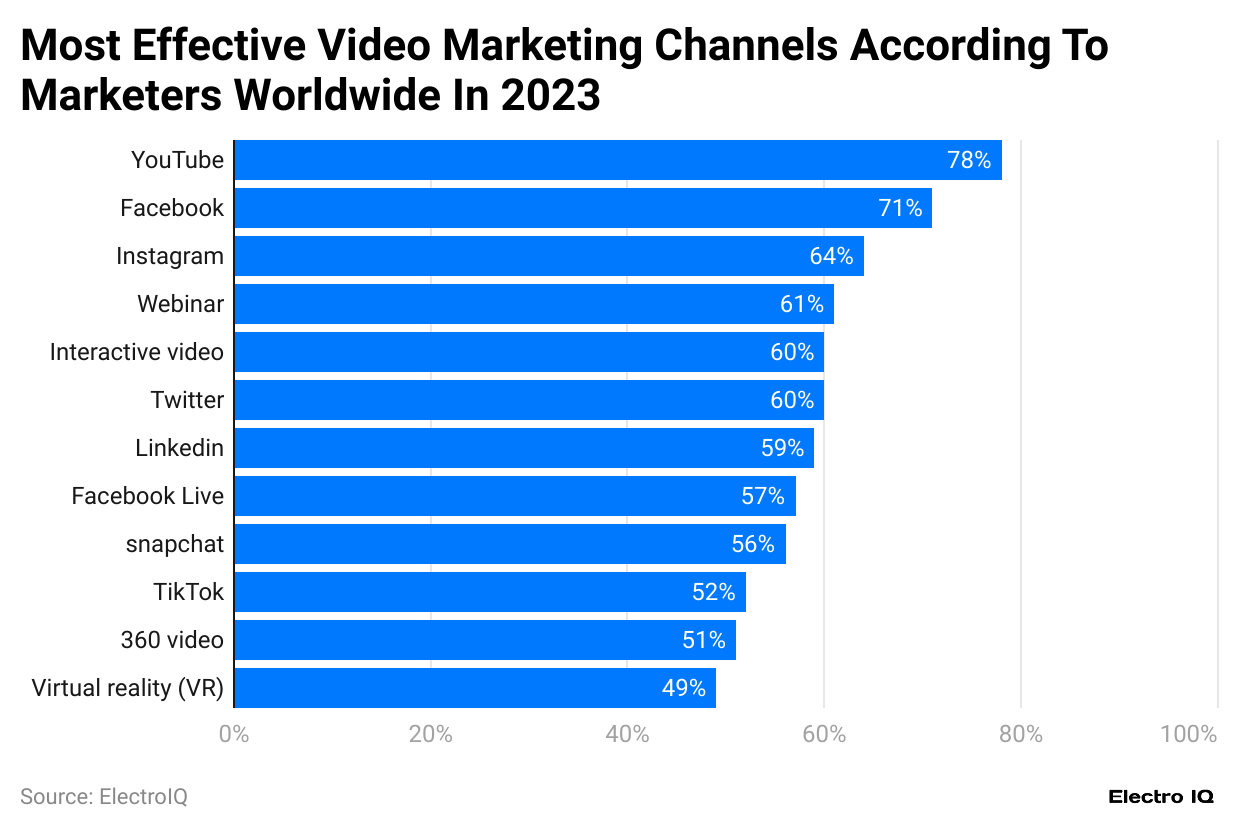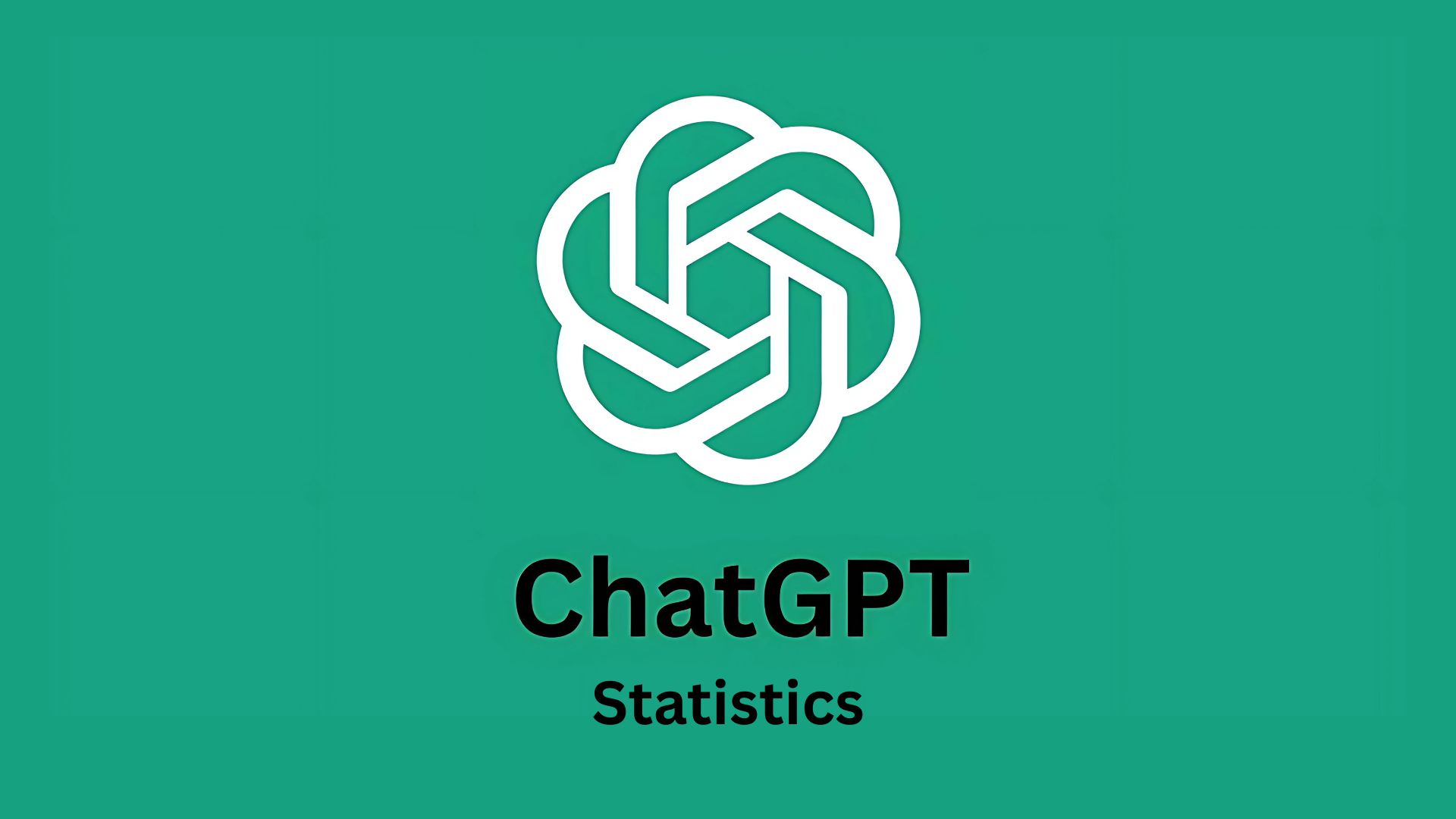Video Marketing Statistics By Revenue, Content Type And Users
Updated · Nov 04, 2024

Table of Contents
- Introduction
- Editor’s Choice
- Video Platform Used For Marketing
- Most Effective Video Marketing Channels
- Budget Spending By Video Marketers
- Different Videos Used in Marketing
- Connected TV Advertising Revenue
- Advertisement Revenue of FAST Services
- Youtube Advertising Revenue
- Average Time Spent on Online Video Platforms
- The Most Popular Video Content Type
- Number of YouTube Users Worldwide
- Video Marketing Facts
- Conclusion
Introduction
Video Marketing Statistics: Video marketing focuses on online display advertisements that usually occur before video streams. As we go forward, we will learn about video marketing statistics and crucial information regarding advertising. In today’s digital era, video marketing has rapidly become a cornerstone for brand promotion, effectively captivating audiences and driving engagement like never before.
From streaming ads to social media snippets, video content is everywhere, offering a visually compelling way for businesses to connect with potential customers. By the end, the reader will learn key insights that showcase video marketing’s influential role in modern advertising.
Editor’s Choice
- YouTube dominates video marketing, with 90% of marketers utilizing the platform
- Music videos lead content popularity with 48.2% global reach
- CTV advertising revenue is projected to reach USD 42.5 billion by 2028
- Average weekly online video consumption peaked at 19 hours in 2022
- YouTube users expected to reach 1,165.85 million by 2029
- 42% of marketers spend between USD 0-USD 500 on average video production
- Testimonial videos are most popular among marketers at 39%
Video Platform Used For Marketing

(Reference: statista.com)
- Video Marketing Statistics show that it has become essential across various platforms, with YouTube, social media, and professional networks dominating the space in 2023. Marketers are prioritizing accessible and widely used platforms while the adoption of newer, immersive formats like VR is growing gradually.
- YouTube is the leading platform for marketing purposes in 2023, and it is used by 90% of marketers worldwide, followed by Facebook with 86%, Instagram with 79%, LinkedIn with 76%, webinars with 70%, Facebook Live with 68%, Virtual Reality with 56%, and 360 videos with 56%.
Most Effective Video Marketing Channels

(Reference: statista.com)
- Video Marketing Statistics show that social media platforms like YouTube, Facebook, and Instagram are leading in video marketing effectiveness, with professional or immersive channels like LinkedIn and VR still emerging in appeal among marketers.
- YouTube is the most effective video marketing channel, with 78% of marketers using it, followed by Facebook with 71%, Instagram with 64%, Webinar with 61%, Interactive video with 60%, Twitter with 60%, LinkedIn with 59%, Facebook Live with 57%, Snapchat with 56%, TikTok with 52%, 360 video with 51%, Virtual reality (VR) with 49%.
Budget Spending By Video Marketers

(Reference: statista.com)
- Video Marketing Statistics show that marketers prefer to spend conservatively on video production, with a strong inclination towards budgets under USD 5,000, indicating a cost-effective approach to video marketing.
- Most marketers, 42%, spend between USD 0–USD 500 on an average video, indicating a preference for budget-friendly video production.
- About 25% of marketers allocate between USD 1,000–USD 5,000 per video, and a smaller group, 9%, spends between USD 5,000–USD 10,000 on video content.
- Only 4% of marketers invest over USD 20,000 in a single video,
Different Videos Used in Marketing

(Reference: statista.com)
- Video Marketing Statistics show marketers prefer customer-centered video formats like testimonials, explainers, and social media videos, focusing on content that builds trust and communicates value to audiences.
- Testimonial videos are the most popular among marketers, with 39% using them to engage audiences through authentic customer stories, followed by Explainer videos with 38%, Social media videos with 34%, Presentation videos with 34%, Product demo videos with 32%, Sales videos with 30%, Teaser videos with 30%, Video ads with 30%, Customer service videos with 28%, Videographics with 25%, Employee onboarding videos with 25%, Customer onboarding videos with 22%, Staff training videos with 22%, App demo videos with 22%.
Connected TV Advertising Revenue

(Reference: statista.com)
- Video Marketing Statistics show that the global CTV advertising market is experiencing robust growth, indicating an increasing shift toward digital advertising on connected television platforms, driven by higher consumer adoption of CTV and advertisers’ focus on targeted digital-first ad strategies.
- CTV advertising revenue grew significantly from USD 12.9 billion in 2020 to an estimated USD 25.9 billion by 2023.
- Revenue is predicted to continue to grow, reaching USD 42.5 billion by 2028.
Advertisement Revenue of FAST Services

(Reference: statista.com)
- Video Marketing Statistics show that the FAST streaming TV sector is expanding rapidly, reflecting advertisers’ growing preference for ad-supported streaming platforms as they become increasingly popular among consumers worldwide.
- Advertising revenue for FAST services increased from USD 6 billion in 2022 to a forecasted USD 10.39 billion by 2025, marking a steady upward trend.
- The revenue is expected to reach USD 18 billion by 2028, indicating continuous growth in ad spending on FAST platforms.
Youtube Advertising Revenue

(Reference: statista.com)
- Video Marketing Statistics show that video advertising revenue on YouTube is increasing consistently.
- In 2017, the advertising revenue was USD 8150 million; it increased to USD 31,510 million by the end of 2023.
Average Time Spent on Online Video Platforms

(Reference: statista.com)
- Video Marketing Statistics show a notable increase in the average time spent on online video content over the years, highlighting the growing importance of digital video as a dominant form of entertainment.
- The average weekly time spent on online videos rose from 10.5 hours in 2018 to a peak of 19 hours in 2022, showing a consistent upward trend over the years.
- By the end of 2023, the viewership trend had decreased to 17 hours per week.
The Most Popular Video Content Type

(Reference: statista.com)
- Video Marketing Statistics show that different video content types have garnered significant popularity among the crowd.
- Music video has the highest video content popularity, with 48.2%, followed by Comedy, meme, or viral videos at 35%, video live stream at 27.7%, educational videos at 26%, tutorial or how-to videos at 25.8%, sports clip or highlights video with 25.7%, product review video with 25.3%, sports match or commentary with 23.5%, influencer videos and vlogs with 23.4%, and gaming video with 22.2%.
Number of YouTube Users Worldwide

(Reference: statista.com)
- Video Marketing Statistics show that the number of YouTube users worldwide is increasing consistently.
- While in 2020, there were 608.64 million users, it increased to 868.4 million by the end of 2023.
- It is predicted that by the end of 2029, there will be 1,165.85 million users worldwide, signifying its rising popularity.
Video Marketing Facts
- In recent years, video marketing has emerged as a dominant force in the digital marketing landscape. As of 2023, businesses are increasingly allocating a significant portion of their advertising budgets to video content, and this trend shows no signs of slowing down. Video marketing statistics highlight that this format has been particularly effective in engaging audiences, with platforms like YouTube, Facebook, and Instagram leading the charge. With advancements in video production technology and consumer preference for visual content, video marketing has become an essential strategy for companies worldwide.
- In 2023, video advertising spending across platforms is estimated to have reached an impressive USD 52 billion in the United States alone. This figure is projected to grow further as businesses recognize the power of video in capturing attention and conveying messages effectively. The return on investment (ROI) from video marketing has proven to be substantial, with 87% of marketers stating that video has increased their website traffic and 80% reporting that it has directly boosted their sales. Video marketing statistics underscore the effectiveness of video as a means to convert viewers into customers, making it a valuable asset for companies aiming to improve their bottom line.
- One notable trend in 2023 is the rise of short-form videos popularized by platforms like TikTok and Instagram Reels. These bite-sized videos, typically lasting under a minute, have become highly effective at engaging younger audiences, who favor quick and visually captivating content. TikTok, for example, has an estimated 52% of marketers reporting high engagement levels through video content. Short-form video marketing statistics also reveal that 78% of viewers are likelier to watch a complete short-form video than a longer one, making it a preferred choice for brands targeting millennials and Gen Z consumers.
- In addition to short-form videos, live streaming has gained traction as a powerful tool for real-time engagement. In 2023, video marketing statistics indicate that live video content accounted for 27.7% of all video content shared by brands. Platforms like Facebook Live, Instagram Live, and LinkedIn Live have enabled businesses to interact directly with audiences, host Q&A sessions, and showcase product launches, fostering a sense of authenticity and transparency. According to market research, live videos have an engagement rate of nearly 10 times higher than pre-recorded videos, making them highly effective for brand building and customer engagement.
- Explainer videos also continue to play a vital role in marketing strategies. As of 2023, 38% of marketers used explainer videos to simplify complex ideas and products. These videos are particularly valuable in sectors like technology, finance, and healthcare, where products or services may require a step-by-step guide to understand fully. Video marketing statistics highlight that consumers are 73% more likely to purchase a product after watching an explainer video. Furthermore, businesses using explainer videos report a 54% higher customer satisfaction rate, contributing to increased brand loyalty and repeat purchases.
- Social media platforms have proven indispensable for video marketing. YouTube remains the top platform, with 90% of marketers using it for video marketing. Facebook and Instagram are closely followed, with 86% and 79% adoption rates, respectively. LinkedIn, traditionally a B2B platform, has also seen an increase in video content, with 76% of marketers leveraging it for business-oriented videos. These platforms offer various advertising options, from in-feed videos to stories, providing brands with diverse ways to reach their target audience. Video marketing statistics also show that paid video ads on social media yield 10-15% higher engagement rates than non-video ads, reinforcing the importance of video in social media advertising.
- User-generated content (UGC) has emerged as another effective form of video marketing. In 2023, UGC accounted for 25% of the video content brands used for promotional purposes. This type of content, often created by satisfied customers or influencers, adds credibility and authenticity to brand messaging. Video marketing statistics reveal that consumers trust UGC videos 2.4 times more than brand-produced videos, and 79% say user-generated content highly impacts their purchasing decisions. The popularity of UGC is expected to grow in 2024 as more brands leverage this cost-effective strategy to build trust and foster community around their products.
- Interactive videos are gaining popularity, with 60% of marketers incorporating clickable elements, quizzes, and polls into their content. This format enhances user engagement, allowing viewers to interact with the video in real-time and making the viewing experience more personalized. Video marketing statistics indicate that interactive videos have a 40% higher completion rate than standard videos, as viewers are actively involved in the content. In 2024, interactive video usage is projected to rise by 15%, with companies exploring new ways to make their video content more immersive and engaging.
- Investing in high-quality video content remains a priority for marketers, with 42% of companies spending between USD 0 and USD 500 per video in 2023. Another 18% allocate budgets between USD 500 and USD 1,000, while 25% spend between USD 1,000 and USD 5,000 per video. For larger brands, video production costs can exceed USD 20,000, especially for high-production-value content like TV commercials or cinematic ads. This investment is justified, as video marketing statistics suggest that high-quality video content significantly impacts brand perception, with 84% of consumers associating a polished video presence with a credible and trustworthy brand.
- Video marketing is not only effective on social media but also on websites. As of 2023, 68% of websites used video on their homepage to capture visitors’ attention instantly. This practice is particularly prevalent in the e-commerce industry, where product demo videos and customer testimonials serve to reassure potential buyers. Video marketing statistics reveal that adding video to a landing page can boost conversion rates by up to 80%, underscoring the role of video in the buyer’s journey.
- Looking ahead to 2024, the adoption of augmented reality (AR) and virtual reality (VR) in video marketing is expected to grow. Currently, 56% of marketers have experimented with 360-degree videos and VR content, creating immersive brand experiences for viewers. Video marketing statistics project that investment in AR and VR technologies for video marketing will increase by 20% in 2024 as brands seek innovative ways to engage consumers and differentiate themselves in a competitive market.
- In summary, the impact of video on marketing strategies is undeniable. The 2023 video marketing statistics reveal that companies across various industries leverage diverse video formats—short-form, live, interactive, and user-generated content—to connect with their target audiences. The preference for video as a medium continues to grow, and as brands increase their investment in video, they can expect enhanced customer engagement, improved ROI, and strengthened brand loyalty. With ongoing technological advancements, the video marketing landscape is poised for continued growth and innovation in 2024, solidifying video’s place as a cornerstone of modern marketing strategies.
Conclusion
Video marketing has proven invaluable in the modern digital landscape, with statistics demonstrating its growing influence across all business sectors. Video Marketing Statistics show a clear trend toward increased adoption of video content, with platforms like YouTube, Facebook, and Instagram leading the charge.
The diversity of video formats, from testimonials to interactive content, provides marketers with versatile options to engage their target audiences effectively. The evolution of technology, particularly in areas like Virtual Reality and interactive video content, points to exciting new opportunities for brands to connect with their audiences.
Sources
FAQ.
YouTube leads, and 90% of marketers use it for video marketing.
The majority (42%) spend between $0-$500 per video.
Music videos lead with 48.2% global reach, followed by comedy and meme videos.
As of 2023, people spend an average of 17 hours per week watching online videos.
CTV advertising revenue is expected to reach $42.5 billion by 2028.

Saisuman is a skilled content writer with a passion for mobile technology, law, and science. She creates featured articles for websites and newsletters and conducts thorough research for medical professionals and researchers. Fluent in five languages, Saisuman's love for reading and languages sparked her writing career. She holds a Master's degree in Business Administration with a focus on Human Resources and has experience working in a Human Resources firm. Saisuman has also worked with a French international company. In her spare time, she enjoys traveling and singing classical songs. Now at Smartphone Thoughts, Saisuman specializes in reviewing smartphones and analyzing app statistics, making complex information easy to understand for readers.










